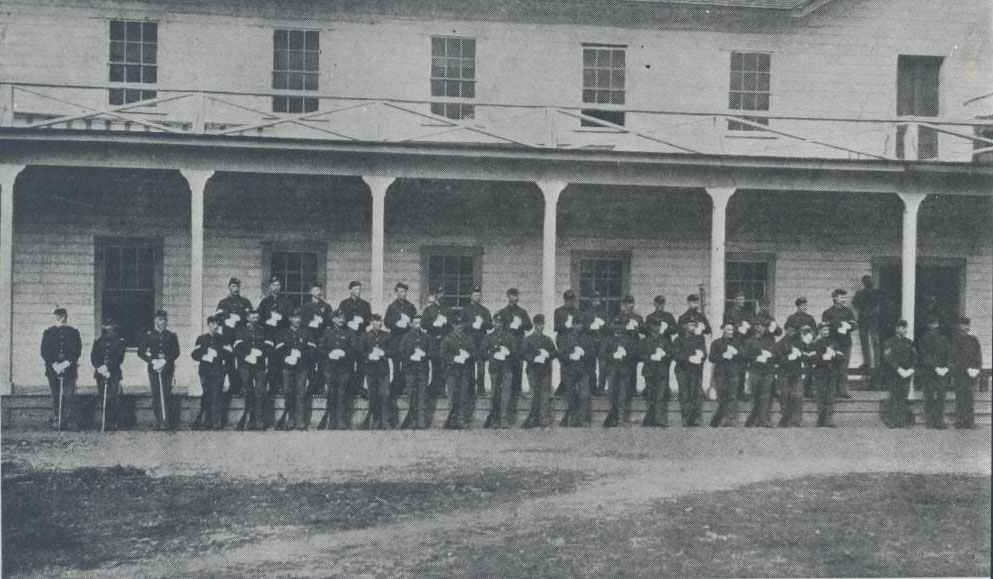Overview
Oregonians had enjoyed statehood for only two years when the Confederacy fired on Fort Sumpter on April 12, 1861. The state was already divided politically when it voted in its first presidential election in 1860. Abraham Lincoln barely edged out his opponents, benefitting from a split in the Democratic Party and the consolidated support of Republicans, who were in the minority in Oregon. That divide was deepened during the Civil War, as Oregonians grappled with their own attitudes toward slavery, emancipation, race, and secession. Oregon newspapers, which operated as instruments of political parties, were monitored for pro or anti-Southern sympathies. Those which supported the South were suppressed, including the Portland Daily News and the Eugene Herald. Black Oregonians watched the war carefully and celebrated the Emancipation Proclamation—an event acknowledged each year for many years after.
The Oregonians perhaps most affected by the Civil War were those who had been confined to the newly formed Indian reservations. The regular army units based on the West Coast were sent east and replaced by volunteer units, whose primary purpose was to facilitate white settlement and suppress the Indian population. The land and resources in the West were critical to the Union’s war strategy, so the building of roads and railways—with free or cheap land waiting for overlanders—helped secure the region away from the Confederacy. Treaties had largely secured tribal lands for newcomers, but many Native people resisted relocation and resented illegal squatting on reservation lands by white miners and farmers. The volunteers closely surveilled Native people, expecting violence at any moment. In reality, there were few conflicts. Still, the army built several forts around the state and would ride out in force to Native communities at any sign of discord. Those forts came into heavy use near the end of the Civil War in 1864 when the U.S. Army and the “Snake Indians,” comprised of Northern Paiute, Bannock, and Western Shoshone, entered into one of the deadliest Indian wars in the West. For the next several decades, Indian wars occupied the regular armed forces, regarrisoned in the West after the end of the Civil War.
Content Standards
- HS.1 Analyze the impact of constitutional amendments on groups, individuals, institutions, national order.
- HS.5 Evaluate the relationships among governments at the local, state, tribal, national, and global levels.
- HS.7 Analyze political parties, interest and community groups, and mass media and how they influence the beliefs and behaviors of individuals, and local, state, and national constituencies.
- HS.55 Analyze the complexity of the interaction of multiple perspectives to investigate causes and effects of significant events in the development of world, U.S., and Oregon history.
- HS.60 Analyze the history, culture, tribal sovereignty, and historical and current issues of the American Indian/Alaska Native/Native Hawaiian in Oregon and the United States.
- HS.65 Identify and analyze the nature of systemic oppression on ethnic and religious groups, as well as other traditionally marginalized groups, in the pursuit of justice and equality in Oregon, the United States and the world.
- HS.67 Evaluate historical sources for perspective, limitations, accuracy, and historical context.
- HS.68 Select and analyze historical information, including contradictory evidence, from a variety of primary and secondary sources to support or reject a claim.
- HS.69 Create and defend a historical argument utilizing primary and secondary sources as evidence.
Additional Sources
Oregon Encyclopedia Entries
McKay, Floyd. "Civil War, Newspaper Suppression." The OE
Nokes, Greg. "Black Exclusion Laws." The OE
Lewis, David. "Philip Henry Sheridan." The OE
Nelson, Kurt. "Fort Stevens." The OE
Nelson, Kurt. "Fort Klamath." The OE
Etulain, Richard. "Edward Baker." The OE
Peterson Del Mar, David. "14th Amendment." The OE
Peterson Del Mar, David. "15th Amendment." The OE
Articles and Books
Lalande, Jeff. “‘Dixie’ of the Pacific Northwest: Southern Oregon’s Civil War.” Oregon Historical Quarterly 100, 1999: 33–72.
Edwards, Thomas G. “Six Oregon Leaders and the Far-Reaching Impact of America’s Civil War.” Oregon Historical Quarterly 100, 1999: 8–32.
Richard, K. Keith. “Unwelcome Settlers: Black and Mulatto Oregon Pioneers.” Oregon Historical Quarterly 82, 1983: 29-56, 173-191.
Johnannsen, Robert W. “The Oregon Legislature and the Fourteenth Amendment.” Oregon Historical Quarterly 51, 1950: 3-12.
Taylor, Quintard. “Slaves and Free Men: Blacks in the Oregon County, 1840-1860.” Oregon Historical Quarterly 83, 1982: 153-170.
McLagan, Elizabeth. A Peculiar Paradise: A History of Blacks in Oregon, 1788-1940. Portland, Oreg., 1980.
Oregon Public Broadcasting Documentaries
Additional Lesson Plans
Digital Public Library of America. Primary Source Sets Lesson Plan. Manifest Destiny
Digital Public Library of America. Primary Source Sets Lesson Plan. The Fifteenth Amendment
Cite
The OE. "Symptoms of hostilities": the Civil War in Oregon. 2020. Retrieved from The Oregon Encyclopedia, https://www.oregonencyclopedia.org/packets/2. (Accessed April 22, 2025.)Teacher Guide
-
Have students examine the following documents. 1. John & Almira Dimick Letters 2. Oregon Cavalry Volunteers Uniform 3. Broadside, To Arms! 4. Proceedings of the Wasco Council, 1855 What were the main causes of conflict between the U.S. Army and Native people during the Civil War period in Oregon?
-
Have students examine the following documents. 5. Grand Emancipation Celebration 6. Suffrage Committee Report, 1857 7. Broadside: Lecture by Mr. George P. Riley What effect did the passage of the 14th and 15th Amendments have on the slavery and suffrage sections of the Oregon Constitution?
-
Have students examine the following documents. 8. Subscriptions to US Sanitary Commission 9. Union League Secret Code and Translation 10. National Election Ticket, California, 1864 How did Oregonians deal with their conflicted political feelings in national elections over the connection between slavery and Southern secession?
-
What do these documents tell us about Oregon statehood? Who is allowed statehood in Oregon? Who does statehood benefit?
-
How has the exclusion of Blacks, Native Americans, and other communities of color in the founding of Oregon's statehood shaped the history of the state in the 21st century? What current issues in Oregon are connected to statehood? Begin your research by watching Oregon Black History Timeline.

